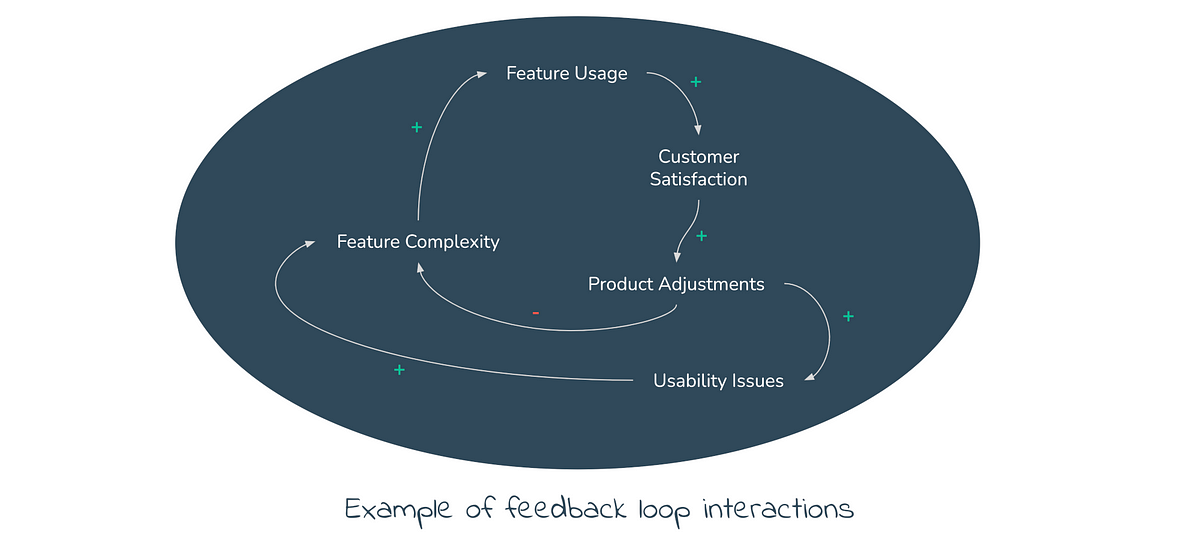
This is the second post in a series exploring the fundamentals of Systems Thinking. This is an approach that helps us make sense of complex situations by considering the whole system rather than just its individual parts.

This series is made up of:
- Part 1: Three Key Principles
- Part 2: Understanding Feedback Loops (this post)
- Part 3: Identifying Leverage Points
In the first post, we explored the foundational principles of Systems Thinking: Drawing a Boundary, Multiple Perspectives, and Holistic Thinking. Now, we’ll build on that foundation by examining Feedback Loops, another crucial concept in Systems Thinking.
Feedback loops are essential for understanding how systems behave, adapt, and evolve over time. By mastering the dynamics of feedback loops, you can identify how small changes can ripple through a system, leading to significant outcomes, whether intended or unintended.
1. What are feedback loops?
“You think that because you understand ‘one’ that you must therefore understand ‘two’ because one and one makes two. But you forget that you must also understand ‘and.’” — Donella Meadows
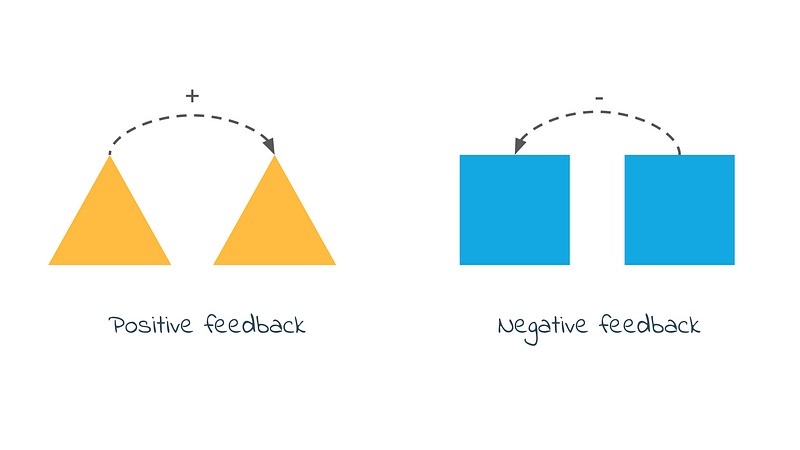
Feedback loops are the mechanisms by which systems regulate themselves. They can either reinforce a particular behaviour (positive feedback) or counteract it to maintain stability (negative feedback). Understanding these loops helps us see how systems respond to internal and external changes, leading to growth, adaptation, or stability.
For instance, a classic example of a negative feedback loop is a thermostat regulating room temperature. When the temperature rises above the set point, the thermostat turns off the heating. When the temperature drops below the set point, the thermostat turns the heating back on. This loop maintains the room’s temperature within a desired range, counteracting any deviations. The thermostat example clearly demonstrates how negative feedback loops work to maintain stability within a system, bringing it back to a set equilibrium when it deviates.
On the other hand, social media platforms often rely on positive feedback loops to increase user engagement. When a user interacts with content, the platform’s algorithm shows more similar content, increasing the likelihood of further engagement. This creates a reinforcing cycle where user behaviour drives more of the same behaviour, leading to increased overall engagement. This example illustrates how positive feedback loops can amplify behaviours, sometimes leading to rapid growth or creating echo chambers where only certain types of content are repeatedly reinforced.
Feedback loops are crucial for identifying how systems behave over time, which ties back to the principles we discussed in the first post, particularly the importance of considering Holistic Thinking.
2. Negative feedback loops
“The major problems in the world are the result of the difference between how nature works and the way people think.” — Gregory Bateson
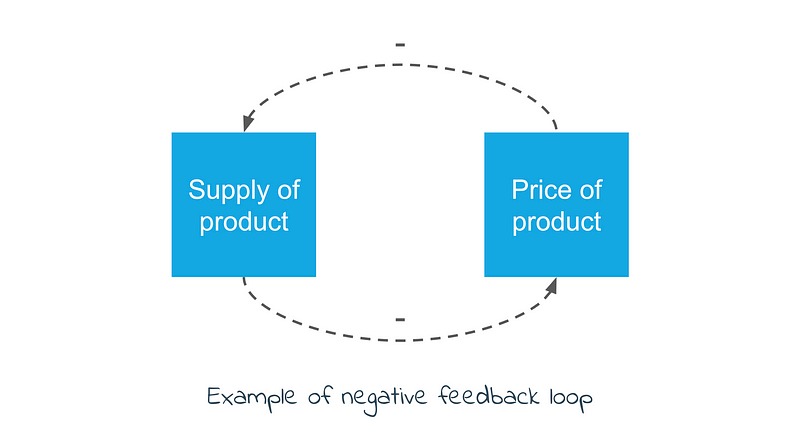
Negative feedback loops work to stabilise a system by counteracting changes. These loops are vital for maintaining equilibrium and preventing a system from spiralling out of control.
For example, in economics, the supply and demand mechanism operates as a negative feedback loop. When the supply of a product exceeds demand, prices tend to fall, which in turn reduces supply as producers cut back on production. Conversely, when demand exceeds supply, prices rise, encouraging increased production. This self-regulating process helps to stabilise markets by bringing supply and demand into equilibrium, preventing extreme fluctuations in prices and availability.
It’s important to understand that in the context of Systems Thinking, “negative” doesn’t imply something bad or undesirable. Instead, it refers to the type of feedback that counteracts changes, helping to stabilise a system and maintain equilibrium. Negative feedback loops are essential for preventing systems from spiralling out of control, ensuring they remain balanced and functional.
3. Positive feedback loops
“The only thing harder than starting something new is stopping something old.” — Russell Ackoff
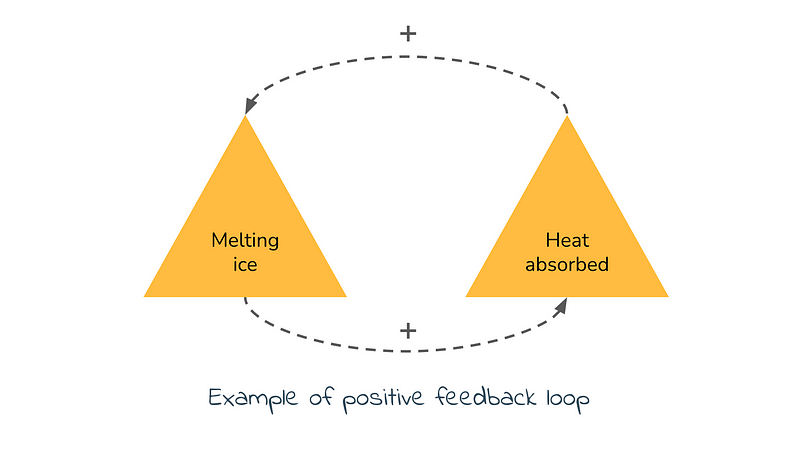
Positive feedback loops amplify changes in a system, often leading to exponential growth or decline. These loops are self-reinforcing, meaning that as a particular change occurs, it triggers more of the same change, leading to potentially dramatic effects.
For example, in the context of climate change, positive feedback loops play a significant role in accelerating global warming. One such loop involves the melting of polar ice. As the ice melts, less sunlight is reflected back into space, and more heat is absorbed by the Earth’s surface, which in turn leads to further ice melt. This self-reinforcing loop accelerates the warming of the planet, contributing to increasingly severe climate impacts.
Again, it’s important to note that a “positive” feedback loop doesn’t necessarily have morally beneficial consequences — rather, it refers to the amplifying nature of the loop itself, which can drive both beneficial and harmful changes.
4. The interaction of Feedback Loops in Systems
“The purpose of a system is what it does.” — Stafford Beer
In most systems, positive and negative feedback loops do not operate in isolation; they interact with each other, creating complex and dynamic behaviours. This interaction can make systems resilient, allowing them to adapt to changes and maintain stability, or it can make them vulnerable, leading to oscillations, chaotic behaviour, or even collapse if not properly managed. Understanding how these loops interplay is crucial for effective system management and intervention.
In product management, the balance between feature usage and product complexity is shaped by the interaction of feedback loops. When a feature is widely used and appreciated, customer satisfaction increases, leading the product team to enhance or expand the feature (positive feedback). As the feature becomes more complex, it may introduce usability issues, decreasing customer satisfaction (negative feedback). This interaction helps maintain a balance within the product, ensuring it continues to meet customer needs without becoming overly complicated.
A similar interplay of feedback loops occurs when managing product adjustments. Increasing customer satisfaction through positive feedback can prompt further enhancements, which might initially appear beneficial. Yet, if these enhancements lead to excessive complexity, they may cause usability issues, frustrating users and resulting in negative feedback. This process highlights the delicate balance product managers must maintain to keep their product both innovative and user-friendly, illustrating the challenges of managing feedback loops in product development.
By recognising and analysing these interactions, systems thinkers can identify points of leverage where interventions can either reinforce desirable behaviours or counteract negative trends, leading to more stable and resilient systems.
5. Recognising feedback loops in your work
“Taking action to improve a problematical situation will of course itself change that situation, so that the learning cycle could in principle begin again.” — Peter Checkland
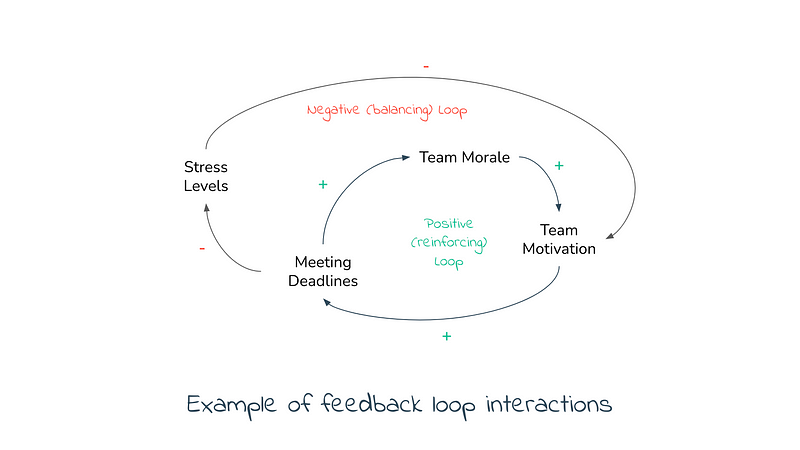
Identifying and understanding feedback loops in your work or organisational context can be a game-changer. These loops are often the invisible threads that weave through processes, projects, and relationships, dictating outcomes and driving behaviours. By recognising these loops, you can gain a deeper understanding of the forces at play and make more informed decisions that lead to sustainable success.
Get started identifying feedback loops:
- Think of an area in your work where specific actions lead to similar outcomes
- Identify the underlying feedback mechanism — is it positive or negative or are multiple loops at play?
- Make adjustments to one part of the system and observe how the system changes
Here’s an example:
- When our team meets a deadline, team morale improves and I’ve noticed that we often meet our deadlines with the same enthusiasm
- This is a positive feedback loop — success breeds further success.
- Figure out what works, and further incentivise it.
Conversely:
- When our team misses a deadline, we tend to become stressed leading to further delays.
- This is a positive feedback loop — the more stressed we are, the more we miss our deadlines.
- We need a win, let’s deprioritise X and focus on Y because it’s an easier task. Then we’ll come back to X when team morale is improved.
Recognising these loops allows you to take proactive steps. If you identify a positive feedback loop that is driving beneficial outcomes, consider how you might reinforce or expand this loop. Perhaps you could introduce additional incentives or recognition programs to further enhance the team’s motivation and productivity. On the other hand, if you uncover a negative feedback loop that is leading to undesirable results, it’s crucial to intervene early. For example, introducing stress management resources or adjusting timelines could help break the cycle and restore balance.
Feedback loops are not limited to project management; they are pervasive in all areas of work, from customer service to organisational culture. In customer service, a positive feedback loop might occur when excellent service leads to customer satisfaction, which in turn results in positive reviews and repeat business. Recognising this loop could lead to further investments in training and support for customer service teams. In organisational culture, a feedback loop could exist where open communication leads to trust, which fosters more open communication, creating a virtuous cycle of collaboration and innovation.
By consciously identifying and managing these loops, you can transform potential challenges into opportunities for growth and continuous improvement. This approach not only helps in achieving immediate goals but also contributes to the long-term resilience and adaptability of your organisation.
Conclusion
Feedback loops are a fundamental aspect of Systems Thinking, providing crucial insights into how systems evolve, adapt, and maintain stability. By identifying and analysing these loops, we gain the ability to predict the outcomes of our actions more accurately and craft interventions that are not only effective but sustainable.
At We Are Open Co-op, we specialise in applying Systems Thinking principles, including the detailed analysis of feedback loops, to help organisations navigate and resolve complex challenges. Whether you’re looking to enhance organisational processes, improve project outcomes, or foster better relationships within your team, understanding feedback loops can be transformative.
If you’re curious about how feedback loops influence your work or how Systems Thinking can be integrated into your approach, we’re here to help. Reach out to us to explore the possibilities. And stay tuned for the final post in this series, where we’ll dive into identifying and leveraging key points within systems to drive meaningful and lasting change.
References
- Ackoff, R.L. (1974). Redesigning the Future: A Systems Approach to Societal Problems. New York: Wiley.
- Bateson, G. (1972). Steps to an Ecology of Mind. San Francisco: Chandler Publishing Company.
- Beer, S. (1972). Brain of the Firm. New York: Herder and Herder.
- Checkland, P. (1981). Systems Thinking, Systems Practice. Chichester: John Wiley & Sons.
- Meadows, D.H. (2008). Thinking in Systems: A Primer. White River Junction: Chelsea Green Publishing.
- Schön, D.A. (1983). The Reflective Practitioner: How Professionals Think in Action. New York: Basic Books.
- Vickers, G. (1965). The Art of Judgement: A Study of Policy Making. London: Chapman & Hall.

Discussion